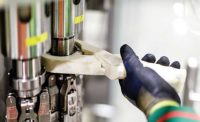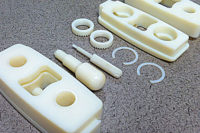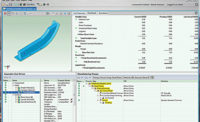Some 74 percent of Americans suffer back pain at least once a year, and 13 percent experience such pain daily. For many, the problem is chronic. Indeed, 54 percent of back-pain sufferers say they’ve had the problem for five years or more.
Treating that pain is big business. For example, market research firm Mordor Intelligence predicts that the worldwide market for spinal surgery devices will increase from $13 billion in 2016 to more than $16.6 billion by 2021—a cumulative annual growth rate of 5 percent.
One company at the forefront of the global spinal surgery market is NuVasive Inc. Based in San Diego, the medical device manufacturer specializes in minimally disruptive surgical products and procedurally integrated products for spinal surgery. Its products focus on applications for spine fusion surgery, including ancillary products and services used to aid in the surgical procedure.
The company’s principal product is Maximum Access Surgery, a minimally disruptive surgical platform. The platform includes software-driven nerve detection and avoidance systems; intraoperative monitoring (IOM) services and support; MaXcess, an integrated split-blade retractor system; and various specialized implants and biologics.
In addition, the company offers an Integrated Global Alignment platform for assessing, preserving and restoring spinal
alignment; MAGEC, a spinal bracing and distraction system for treating early onset scoliosis; and PRECICE, a limb-lengthening system.
Sales have been brisk. Last year, NuVasive saw its gross revenue increase 7 percent, from $962.1 million in 2016 to $1.029 billion in 2017, while net profit more than doubled, from $37.1 million to $83 million.
In 2016, the company invested $45 million in a new manufacturing facility in West Carrollton,, OH, a suburb of Dayton. The company began moving into the 180,000-square-foot facility in July 2016. By the time construction wrapped up in late November 2017, the company had moved 125 employees from an existing factory in nearby Fairborn and was adding another 200 jobs. The company expects the West Carrollton operation to be its global manufacturing hub.
Recently, we spoke with Steve Rozow, NuVasive’s executive vice president for global process transformation, about the company’s new manufacturing facility, production challenges and new technology.
ASSEMBLY: Tell us about the plant in West Carrollton. How is it different than the original Ohio plant?
Rozow: Our prior plant was a small-scale facility, so most of our product was provided by suppliers. As a
high-mix and low-volume manufacturer, we can dramatically improve the responsiveness of the supply chain to our customer demands by scaling our internal manufacturing. Before, we had been very dependent on our suppliers’ schedules, which often added lead-time to our ability to respond to dynamic customer needs.
Additionally, we have equipped the facility with state-of-the-art manufacturing and production equipment, along with installing a manufacturing execution system (MES) that positions us for paperless manufacturing and data-driven operations. This will allow improved costs on the products we produce.
ASSEMBLY: Why was this area chosen?
Rozow: We chose the Dayton area because of the existing talent base for manufacturing. Also, from a business continuity perspective, there are few natural risks that would disrupt an operation. Finally, the economics of the region were also compelling relative to other U.S. options. We’ve been amazingly pleased with the new hires and how quickly they have learned the operation.
ASSEMBLY: What technologies are used in your production?
Rozow: The basic flow of the facility is to machine the components required for the final products and store those in a supermarket. As we get a demand signal for our finished goods assemblies, the correct components are pulled from the supermarket, finished and assembled. This approach allows us to delay the customization of the product as late in the process as possible and further improve responsiveness.
Because we are a low-volume, high-mix operation, this is strategically critical. The underlying technology driving this process is our MES, which provides timely signals for builds and automated tracking of critical information associated with the products
ASSEMBLY: How does the high mix of products affect production?
Rozow: Manufacturing teams often focus on optimizing the cycle times at a given operation. Because we have to have the flexibility of running our many products in small batches, our emphasis for optimization has to be on changing the equipment over to different products in order to minimize equipment downtime. This requires a mix of talent and skills that tend to be less common. As mentioned earlier, the MES system facilitates this emphasis. Plant layout and how we group our equipment to support production of products is also important to optimizing changeovers.
ASSEMBLY: What new technologies have made the biggest impact?
Rozow: Integration of state-of-the-art lathes, mills and inspection equipment to the manufacturing execution system has had the biggest impact and provides a foundation for future advancement of the factory. This automates the collection of data to build a device history record, which is compared with the device master record (the product and process requirements). Traditionally, this is a key source of error and waste in the factory. Additionally, the data provides critical insight to prioritize process improvements.
In the future, we will be using 3D printing technology to create titanium implants that match the structure of bone, allowing for better bone-on and bone-in growth. We will also transfer technology into the plant that allows us to create porosity in polymer implants, which will promote bone growth.
ASSEMBLY: In 2017, NuVasive made $1 billion in gross revenue. What has been the driving factor behind that success?
Rozow: The driver of company growth has been innovative products and surgical procedures that have met unmet clinical needs in spine surgery. Underlying this has been the passion of the organization to transform spine surgery and change patient lives.
ASSEMBLY: What does the future hold for NuVasive?
Rozow: We’re focused on extending this innovation tradition and expanding it to include systems that support clinical advancements. Essentially, those systems will tie surgical outcomes to the preoperative planning process and eventually link to critical aspects of the supply chain.





